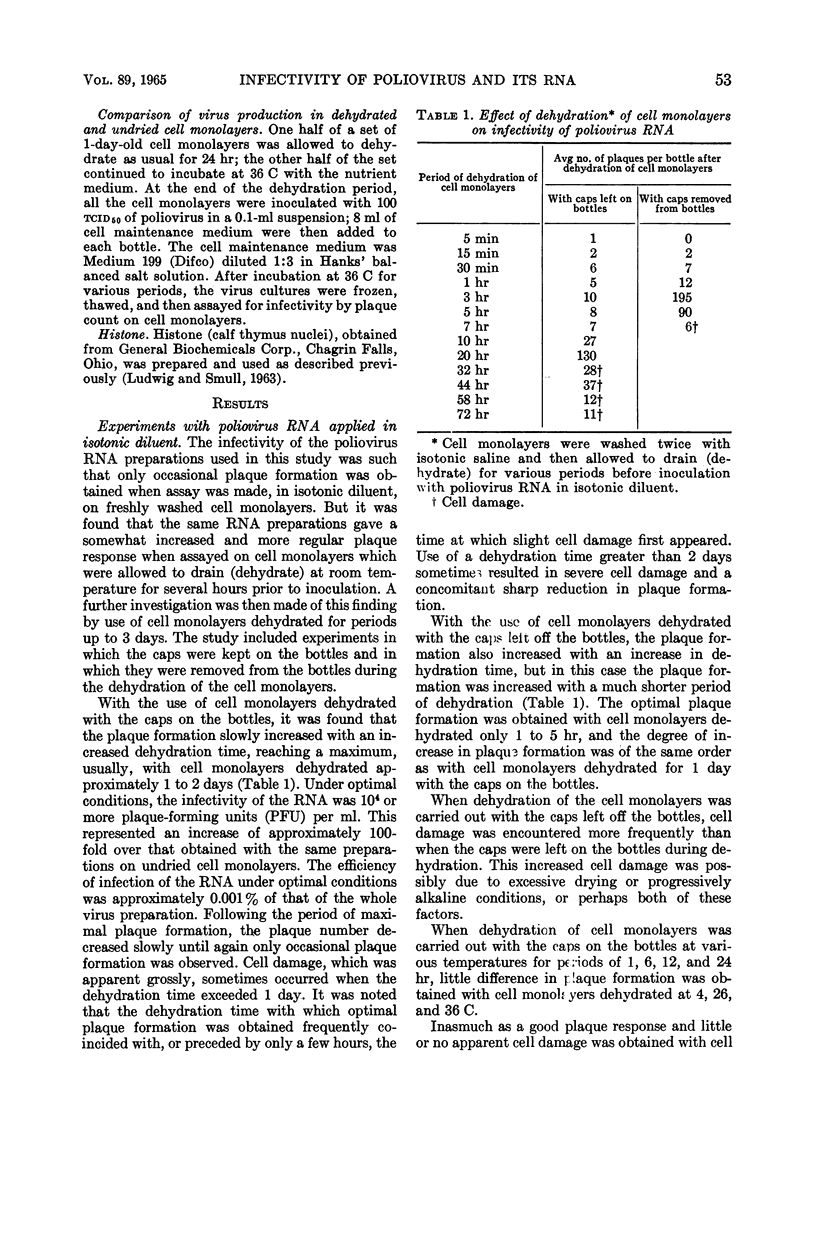Abstract
Smull, Christine E. (The Geisinger Medical Center, Danville, Pa.), and E. H. Ludwig. Infectivity of poliovirus and its nucleic acid for dehydrated HeLa cell monolayers. J. Bacteriol. 89:52–57. 1965.—A study was made of the infectivity of poliovirus ribonucleic acid (RNA), applied in various diluents, and of poliovirus, on cell monolayers which were washed free from their nutrient medium and allowed to dehydrate for periods up to 3 days prior to inoculation. The plaque formation of poliovirus RNA, applied in isotonic diluent, was greatly increased when assayed on cell monolayers dehydrated for certain periods of time. Conditions are described for bringing about optimal plaque formation by this means, and evidence is presented which strongly indicates that dehydration of the cell is an important factor in the increase in plaque formation of the poliovirus RNA. The plaque formation of poliovirus RNA in certain hypertonic diluents and in a basic protein-containing diluent was also improved with the use of dehydrated cell monolayers, whereas the plaque formation of poliovirus varied very little when assayed on cell monolayers dehydrated for periods up to 2 days. Under certain conditions, the size of the plaques increased as the dehydration time of the cell monolayers was increased. This was true with plaques initiated either by poliovirus or the nucleic acid. Further investigation in these cases revealed that virus production at given times was considerably greater in the dehydrated than in the undried cell monolayers.
Full text
PDF





Selected References
These references are in PubMed. This may not be the complete list of references from this article.
- ALEXANDER H. E., KOCH G., MOUNTAIN I. M., VAN DAMME O. Infectivity of ribonucleic acid from poliovirus in human cell monolayers. J Exp Med. 1958 Oct 1;108(4):493–506. doi: 10.1084/jem.108.4.493. [DOI] [PMC free article] [PubMed] [Google Scholar]
- BOEYE A. Induction of a mutation in poliovirus by nitrous acid. Virology. 1959 Dec;9:691–700. doi: 10.1016/0042-6822(59)90158-8. [DOI] [PubMed] [Google Scholar]
- CHAPMAN-ANDRESEN C., PRESCOTT D. M. Studies on pinocytosis in the amoebae Chaos chaos and Amoeba proteus. C R Trav Lab Carlsberg Chim. 1956;30(5):57–78. [PubMed] [Google Scholar]
- CHAPMAN-ANDRESEN C. Pinocytosis of inorganic salts by Amoeba proteus (Chaos diffluens). C R Trav Lab Carlsberg Chim. 1958;31(6):77–92. [PubMed] [Google Scholar]
- DUBES G. R., KLINGLER E. A., Jr Facilitation of infection of monkey cells with poliovirus "ribonucleic acid". Science. 1961 Jan 13;133(3446):99–100. doi: 10.1126/science.133.3446.99. [DOI] [PubMed] [Google Scholar]
- ELLEM K. A., COLTER J. S. The interaction of infections ribonucleic acid with a mammalian cell line. I. Relationship between the osmotic pressure of the medium and the production of infectious centers. Virology. 1960 Jun;11:434–443. doi: 10.1016/0042-6822(60)90085-4. [DOI] [PubMed] [Google Scholar]
- ELLEM K. A., COLTER J. S. The intzraction of infectious ribonucleic acids with mammalian cells. III. Comparison of infection and RNA uptake in the HeLa cell-polio RNA and L cell-mengo RNA systems. Virology. 1961 Oct;15:113–126. doi: 10.1016/0042-6822(61)90228-8. [DOI] [PubMed] [Google Scholar]
- HOLLAND J. J., HOYER B. H., McLAREN L. C., SYVERTON J. T. Enteroviral ribonucleic acid. I. Recovery from virus and assimilation by cells. J Exp Med. 1960 Nov 1;112:821–839. doi: 10.1084/jem.112.5.821. [DOI] [PMC free article] [PubMed] [Google Scholar]
- HOLLAND J. J., McLAREN L. C. Improved method for staining cell monolayers for virus plaque counts. J Bacteriol. 1959 Oct;78:596–597. doi: 10.1128/jb.78.4.596-597.1959. [DOI] [PMC free article] [PubMed] [Google Scholar]
- KOCH G., KOENIG S., ALEXANDER H. E. Quantitative studies on the infectivity of ribonucleic acid from partially purified and highly purified poliovirus preparations. Virology. 1960 Mar;10:329–343. doi: 10.1016/0042-6822(60)90024-6. [DOI] [PubMed] [Google Scholar]
- LUDWIG E. H., SMULL C. E. DILUTION OF POLIOVIRUS RIBONUCLEIC ACID AS AN IMPORTANT STEP IN OBTAINING INFECTIVITY WITH HISTONE. J Bacteriol. 1964 Apr;87:964–965. doi: 10.1128/jb.87.4.964-965.1964. [DOI] [PMC free article] [PubMed] [Google Scholar]
- LUDWIG E. H., SMULL C. E. INFECTIVITY OF HISTONE-POLIOVIRUS RIBONUCLEIC ACID PREPARATIONS. J Bacteriol. 1963 Jun;85:1334–1338. doi: 10.1128/jb.85.6.1334-1338.1963. [DOI] [PMC free article] [PubMed] [Google Scholar]
- NORMAN A., VEOMETT R. C. Ribonuclease activity at the HeLa cell surface. Virology. 1961 Aug;14:497–499. doi: 10.1016/0042-6822(61)90347-6. [DOI] [PubMed] [Google Scholar]
- SMULL C. E., LUDWIG E. H. Enhancement of the plaque-forming capacity of poliovirus ribonucleic acid with basic proteins. J Bacteriol. 1962 Nov;84:1035–1040. doi: 10.1128/jb.84.5.1035-1040.1962. [DOI] [PMC free article] [PubMed] [Google Scholar]


